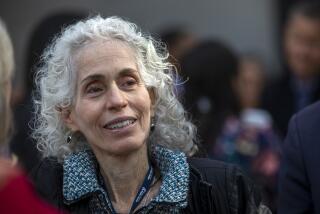Effects of County Welfare Changes Will Be Profound
- Share via
Welfare has a new look for the young mother applying for benefits in Glendale.
Sitting next to her eligibility worker is a job counselor. Down the hall, a child care coordinator awaits. Replacing piles of paperwork is an eight-hour motivational demonstration on how to go about finding employment.
The aim is no longer to determine whether she is eligible for aid and how much, but to divert her from the ranks of the welfare-dependent.
It is the kind of subtle shift that may not grab the attention of the public but is hugely symbolic of the new era of change that is about to take root in counties up and down the state.
The authors of the massive federal welfare overhaul signed into law Aug. 22, 1996, promised a transformation in the nation’s system of public assistance. Now, officials in Los Angles County and elsewhere in California say they are doing their best to fulfill that promise.
As many as 300,000 legal immigrants statewide have received notification that they will lose food stamp benefits Sept. 1. The cutback will affect about 97,000 legal immigrants in Los Angeles County.
Although mandated under the federal legislation, the food stamp losses could cause severe economic hardship, officials fear. Included in the Los Angeles County notifications was information on where to get food in an emergency.
“The termination of food stamps for legal immigrants will constitute the worst aspects of federal welfare reform for Los Angeles County,” said Phil Ansell, who has coordinated the county’s welfare reform efforts.
Other changes are being embraced more readily around the state.
In Glenn County, a remote Northern California enclave of 25,000 people, the face of welfare change is represented by a tractor, which officials say they will now be able to purchase for a small farm cooperative of Southeast Asian immigrants as part of an experimental program for recipients.
Santa Clara County, with a booming economy centered in the Silicon Valley and unemployment at about 3%, has initiated a number of innovative efforts including a “job keeper” program to intercede with businesses on behalf of welfare recipients in jeopardy of being fired.
But it is the changes made in Los Angeles that could reverberate throughout the state and nation.
Los Angeles County is a realm unto itself, with a welfare population larger than the entire public assistance caseloads of all states outside California except New York.
About 1.7 million county residents receive some form of public assistance, with 791,000 people enrolled in the largest cash assistance program, formerly known as Aid to Families With Dependent Children.
The county’s welfare caseload is larger than the entire population of Nebraska, Nevada and 12 other states. Los Angeles County is also home to more legal immigrants than any other county in the nation, and about 372,000 of them receive public assistance.
County leaders have already exercised their clout on several occasions, including using provisions of the federal law to postpone until the end of August cuts in food stamp benefits for most and influencing state and federal authorities to permit other counties to do so as well.
Big changes are afoot elsewhere in the county. Within a year, officials say, the Department of Public Social Services, which administers most welfare programs, will be substantially changed with more sophisticated computers and expanded facilities redesigned to emphasize the new relationship between staff and recipients--who will now be called customers.
The diversion program established in Glendale and 10 other district offices began in April as a voluntary pilot project but will become mandatory and spread to all offices if the county’s welfare plan receives state approval.
The county is also poised to shape policy on the most important welfare issues: how long a mother will be able to remain at home with an infant, what kinds of services for substance abuse, mental health and child support to offer and whether to provide money or vouchers to children whose families have reached the five-year time limit.
Equally important will be the county’s decisions about how to involve private industry, educators and nonprofit agencies in collaborative efforts to transform thousands of impoverished residents into self-sustaining workers.
It is a tremendous undertaking and county officials--cognizant that their decisions will be far-reaching--have adopted a cautious approach, organizing a network of 13 issue-oriented working groups that will sift through dozens of possibilities before presenting a detailed plan of action for approval by the Board of Supervisors in early January.
The county has been slow to fill in the specifics of its plan, partly because it awaited details of the state plan, which was signed into law only this month, and partly because of the massive scope of its undertaking.
All counties must submit detailed plans to the state by January describing welfare-to-work services, and must begin enrolling new applicants in their plans by March of next year.
Los Angeles County sets about its task riding the crest of a rebounding economy and falling caseloads.
Unemployment is at 6.6%, down from 8.3% a year ago. The AFDC caseload has fallen to 791,775 recipients from 863,096 in August 1996. From May to June of this year alone, 17,000 people dropped off the AFDC rolls, according to county figures.
Local officials say that the size of the county may provide advantages in the wealth of resources available--scores of nonprofit service providers, access to some of the best business minds in the country and 13 community college districts.
Its hefty welfare numbers also mean more state and federal monies will flow in, especially since most funding levels are based on higher welfare caseloads of two years ago. The county expects to receive as much as $90 million next year, for example, solely for Joint Training Partnership Act welfare-to-work programs.
County officials say the inflow of money will allow them more creativity to design programs needed to be successful. The phrase “innovation and creativity” has become a mantra for local officials who talk of computer links with job-seeking welfare recipients, one-stop service centers and various subsidies and incentives for recipients and prospective employers.
However, many analysts doubt there are new solutions that will solve the formidable problems of welfare.
“I think it is an irony of welfare reform that there has already been a tremendous amount of experimentation over the last decade . . . and I don’t get the sense that anyone has tremendously new ideas,” said Jean Ross, director of the California Budget Project, a Sacramento-based nonprofit fiscal group.
In addition, officials in many counties are casting a wary eye on neighboring communities, fearful that restrictive measures will unleash a massive movement of poor people looking for the best deal in public assistance.
Nonetheless, counties are forging ahead and their ideas reflect the divergent needs of local communities that run from the sparsely inhabited rural to the densely packed urban.
In Santa Clara County, the welfare caseload has dropped to 17,000 recipients from 26,000 a year ago, said Gil Villagran, manager of the county’s office of community development.
But there are hurdles even in the most robust economies. A recent study concluded that a worker would need to take home a minimum of $20,000 a year to live without any subsidies or aid in Santa Clara County, while a typical worker making minimum wage brings in only about $10,000 after taxes, he said.
Moreover, the county will be hard hit by food stamp cutbacks, with more than 11,000 legal immigrants losing benefits. Villagran said officials are planning a new program in which the county would spend up to $5 million to buy food to distribute to needy legal immigrants.
Glenn County officials have installed computer links in 12 kiosks located in gas stations, post offices, libraries and the county’s only 24-hour grocery to allow recipients to locate jobs and enroll in training programs.
About 3,000 people in Glenn County receive some form of public assistance, a number that would be dwarfed by the foot traffic in just one of Los Angeles County’s eligibility offices, yet it represents more than 10% of the Glenn County population.
Unemployment is at 15% and a full 30% of the cash aid recipients are Southeast Asian refugees, said Human Resource Agency director Kim Gaghagen.
The county’s farm cooperative for aid recipients is made up of about 50 members of five families who grow greens, tomatoes, strawberries and other produce for sale to restaurants and other outlets. It aims to go independent this year and become an employer itself and may do so if the county is able to buy the tractor, said Gaghagen. Previous welfare regulations had prevented the purchase.
“I went to the state of California and they said it’s OK to spend $360,000 to keep people on welfare but not OK to spend $7,000 for a tractor,” said Gaghagen. “This kind of flexibility is the most attractive thing about welfare reform.”
More to Read
Sign up for Essential California
The most important California stories and recommendations in your inbox every morning.
You may occasionally receive promotional content from the Los Angeles Times.














